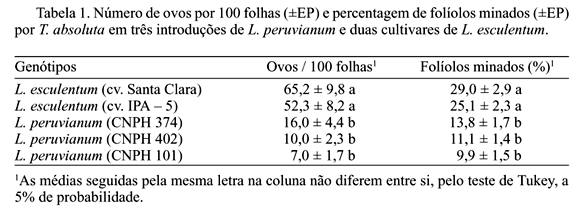The resistance of three accessions of Lycopersicon peruvianum (CNPH 101, 374 and 402) to Tuta absoluta (Meyrick) (Lepidoptera: Gelechiidae) and its chemical causes were studied. The trial was carried out in greenhouse in the Universidade Federal de Viçosa, with two susceptible tomato cultivars (Lycopersicon esculentum cvs. Santa Clara and IPA-5) and three accessions of L. peruvianum. The number of eggs per leaf, short leaf mines (length < 0.5 cm), long leaf mines (length > 0.5 cm) and the percentage of mined leaflets by T. absoluta were evaluated. All hexanic extracts were analyzed with a gas chromatography-mass spectrometer (GC-MS). Accessions of L. peruvianum showed lower number of eggs per leaf, percentage of mined leaflets and number of leaf mines (small and big) than the susceptible cultivars (IPA-5 and Santa Clara). The total number of compounds in the chromatograms was 69, with relative concentrations > 10(6) ions x second. The effect between T. absoluta attack and relative concentrations of the compounds showed by the five peaks (28, 42, 46, 55 and 58) was significant (p<0.05). The main substances related with L. peruvianum were: cyclobutanol; hexadecanoic acid; 9-octadecenoic acid and hexadecane (peaks 28, 42, 46 and 55, respectively). Tetracosane (peak 58) was related with L. esculentum. All substances in the leaf extracts were associated with the susceptibility of tomatoes to T. absoluta.
Insecta; tomato; hexadecanoic acid; hexadecane; tetracosane





